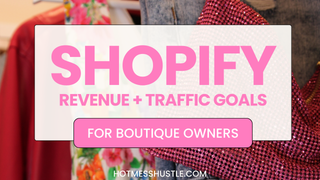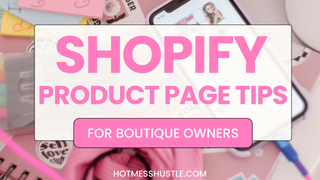⭐THE HOT MESS TEAM BLOG⭐
This month: SEO Writer Alex on WHERE TO PUT YOUR KEYWORDS
Hey bosses! I’m Alex - I’m an SEO Copywriter and Script writer for Hot Mess Consulting.
Today I’m going behind the scenes on some of the copywriting that we do here at Hot Mess, and how to be strategic with your SEO. So I want to share some tips with you on keyword strategy - basically… Where to put your keywords for maximum effect!! I know SEO can be a bit much for some online biz owners, right? But I want to break it down into some really super simple steps that you can take for your store.
But before we get into the nitty gritty on SEO tips, I have to stress that the two BIGGEST things you can do to help your Google Ranking is...
#1 Be mobile-friendly.
#2 Be fast.
This is because User Experience is a MASSIVE part of SEO - so you want people visiting your site to really enjoy it and be able to get around it. So you can also think about your navigation and your customer journey through your site: is it easy, is it intuitive? Test it on your friends and on your customers - this is the best way to know for sure and then you can make any tweaks after.
Now that I’ve said that, what I really want to do today is give you some really actionable tips that you can put into practice right away that will really help your SEO and your organic growth.
So…. the topic today is Keywords! How to pick them, what to do with them! So to think about this another way - WHERE TO PUT YOUR KEYWORDS!
Shopify is a bit more limited in terms of what you can do with keywords compared to Wordpress for example, but there are definitely places to optimize your keywords.
So let’s just do a quick recap on KEYWORDS
This is worth spending a bit of time on to get right. It’s about finding out what words your customers are using to find you in Google Searches or on Pinterest, or however they find you.
So that's a point in itself is to know where your customers come from. Is it Instagram, is it other social media, is it from Google? So I always recommend actually asking your customers when you can, how did you find me?
You could do that in a survey, or in a focus session, or as part of your email marketing. It's notoriously difficult to get responses, but that shouldn’t stop from at least trying, because the more data you have the more powerful it is.
Sometimes the keywords are obvious, like “Womens dresses” - but I recommend that when you get down to the product level, you get more niche than that to find your exact customers so that when they land on your site, they are getting exactly what they were searching for.
And it’s worth remembering that you know what you sell and what the products are called, but your customer might call them something else. So you want to find one key phrase per page or per product or collection and then have a range of similar words that you can also use in your copy or your descriptions.
For example - someone might be searching for flattering pants and you know you sell bell bottoms or a particular cut or pattern which are super flattering, but your customer doesn't know this level of detail or what the style that they are looking for. So you need to have “flattering pants” in your product description.
Need help optimizing your website to increase your revenue?
That's what we do!
We see this quite a lot where boutiques have super cool and creative names for their products but they actually don't match the benefit or the feature that your customer is looking for, and if you can't find a way to link those things together, like including those terms in your description then you'll miss out on that traffic and potentially on that sale.
The way that you’ll know if you are ranking for this is to go on Google Search Console and you can see what you are ranking for on each page. And my advice is to stick to that but double down on that.
You can also use tools like Moz or SEMrush to figure out keywords and you’ll also get the competition and the difficulty rating and the cost for those keywords. Like if something is super competitive, Google will charge more for it in your ad spend if you're doing Google Ads and sponsored posts, so that can be a factor.
So when you have your Keywords, you want to use them strategically.
There are 5 main places you need to be using your keyword:
- Title
- Meta description
- URL
- Image alt tags
- In your content
For your content: definitely include your keywords for each product, collection, webpage, or blog post near the beginning of the title.
And if you’re writing blogs as well, you need to be using these keywords in your copy - for example in your Heading 2 and your main body text.
Best practices are:
- keep your Title and Meta meta description (and your keyword!) unique for each page. If Google sees a bunch of pages with the same meta descriptions, it can get confused and it doesn't really like it.
- Use your keyword where you can, and where it makes sense
- Be clear but appealing. Not click bait, and not so flowery that people can’t understand what benefit they are getting
- Long-tail keywords have 4 or more keywords, and can be more specific than general keywords. Think “Short flowery summer dress” instead of “summer dress” - these are more specific keyword phrases that people are more likely to use when they're closer to a point-of-purchase and they can be really effective
Title
Your page title is what people see at the top of the tab, or also in Google Search results. These ideally should include your keyword, and they need to be 70 characters or shorter - if they are longer, the search engines will shorten them for you automatically.
Meta Descriptions
Meta descriptions have a character limit of 160 characters, so when I’m writing Meta Descriptions, I like to use this tool: Portent SERP Snippet Preview. This helps me keep it within the limits and also see what it would look like in Google.
What these do is tell Google what that page is about -that's why you want them unique - you don’t want to tell Google that you have 30 pages that are all about the same thing, that would look quite spammy, right?
If you're selling a product that is also sold on other sites, it's especially important that you make this stand out and showcase why they should buy it from you.
- What problem does it solve?
- What makes it amazing?
- Why would someone love this?
Use feedback and reviews and the words that your customers already use to describe you or your products, because talking that same language builds trust really nicely.
Alt Tags
Google Images is the second largest search engine in the world. It accounts for more than 20% of all queries Americans performed in 2018.
This means that you can also get traffic from an image search, and in ecommerce this is becoming bigger and bigger. So you need to add Alt Tags - Alternative Text - to your images to describe it, to help Google know what the image is. This needs to be short and sweet, and above all, clear. Use your keywords if you can.
So to add alt text in Shopify. Upload an image > Click “…” > Click “Edit alt text”
One last thing is to add Schema Markup to your pages, but this is quite advanced so I’m not going to go into this in too much detail. But this basically gives Google structured data about your products or categories which it can feature in search results, or rich results, when they have all this extra info like ratings and reviews, and price.
Rich results are great for click throughs and can basically boost your traffic and your conversion rate, or sales. Check your theme to see if you can add “Product” markup, lots of them do, but you can also get apps that will help you do this too if you want.
Final Thoughts...💭
So I know what you’re probably thinking - this is a ton of stuff to do. But really, you should be focusing on some of these things anyway for good customer experience, like site speed and being optimized for mobile.
But keywords strategy is also really important - but it doesn't have to be this big deal. Sure, go track your keywords and your competitors in SEMrush if you want, but you can also keep it super simple and just keep a list of keywords and this list of 5 places to use them (Title Tag, URL, Meta description, image alt tag and content!) and be consistent.
Remember to keep an eye on your google analytics for where your site traffic is coming from because this can be super insightful, and also Google Search Console for your ranking, especially if you have a goal to rank for a specific keyword or keyphrase.
And if you need help with your website - remember that Hot Mess is here for you! The team does an amazing job with you guys, with their clients, and SEO can be a part of that too, so if you need to know more Book a call with us here!
Good luck with finding your keywords, and Happy SEO Days!
Alex x






